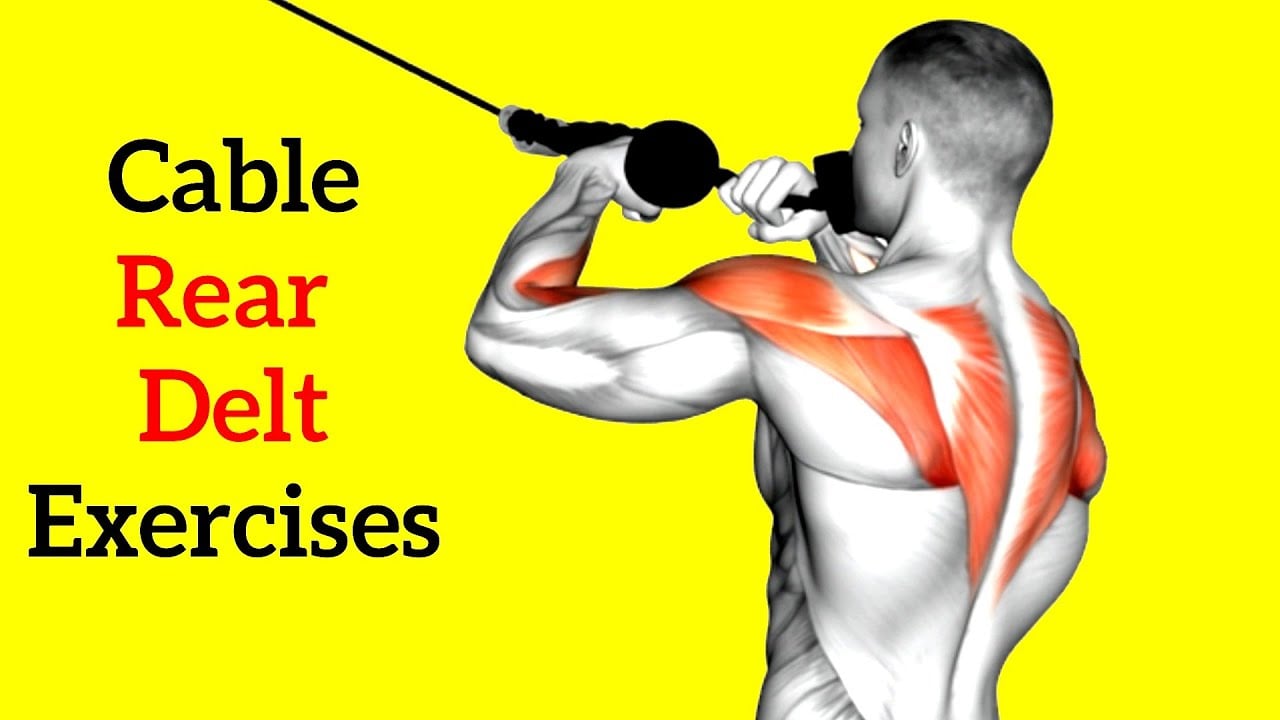The reverse cable fly, often called the standing reverse cable fly, is an excellent exercise for targeting the upper back and shoulder muscles.
While it’s sometimes labeled as an isolation movement, that term can be a bit misleading. A more accurate description would be that it’s a single-joint exercise focused on specific muscle groups.
This move primarily works the posterior deltoids (rear deltoids), along with the trapezius and rhomboids. It’s one of the best ways to enhance the definition and strength of your deltoid muscles.
To perform the rear delt fly, you’ll need a double pulley cable machine with a D-handle. Grab a D-handle in each hand and imagine spreading your arms wide as if you were giving someone a big hug, but in reverse, as opposed to a cable chest fly, where you pull forward.
There are many ways to do these exercises, but most people do them standing up.
- Standing Reverse Cable Fly
- Seated Reverse Cable Fly
- Single-Arm Reverse Cable Fly
- Bent-Over Reverse Cable Fly
- Low-to-High Reverse Cable Fly… Many MORE.
To Stay Motivated: 150+ Gym Workout Motivational Quotes To Stay Fit
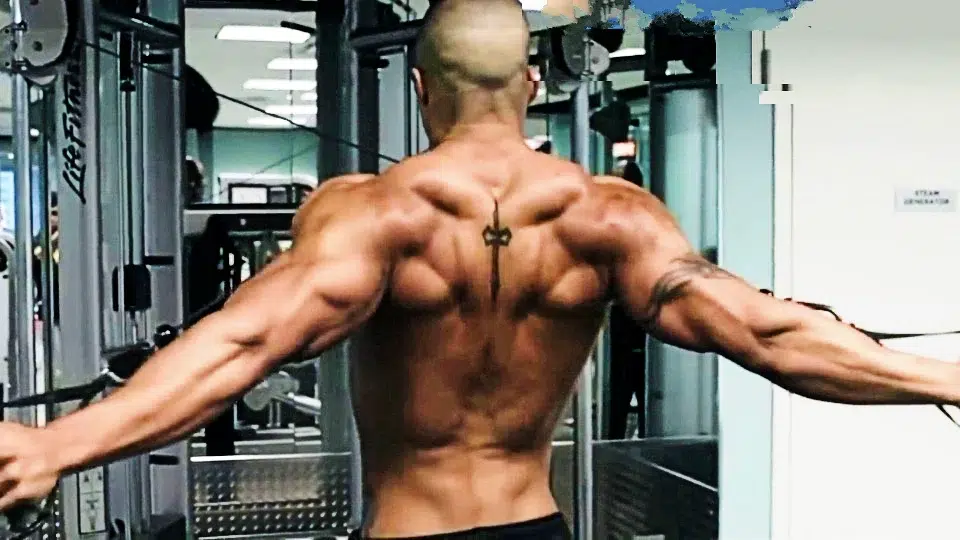
- Reverse Cable Fly Muscles Worked
- How To Do Standing Cable Reverse Fly
- Tips And Forms
- Reverse Cable Fly Variations
- 1. Bent Over Reverse Cable Fly
- 2. Seated Reverse Cable Fly
- 3. Single Arm Standing Reverse Cable Fly
- Benefits Of Reverse Cable Fly
- FAQ
- Is The Cable Rear Delt Fly Good?
- What Muscle Does The Revers Fly Work?
- Is it necessary to use heavy weights for the reverse cable fly?
- Is reverse fly push or pull?
- Why is reverse fly so hard?
- Takeaways
- Rear Delt Cable Exercises for Bigger and Stronger Shoulder
Reverse Cable Fly Muscles Worked
- The reverse cable fly primarily worked the rear deltoid.
- Secondary muscles worked during it, including the trapezius, Rhomboids, Infraspinatus, teres minor, and teres major.
- A handful of other muscles work as synergist muscles and stabilizer muscles, including your erector Spinae, Lateral Deltoid, Obliques, and Rectus abdominis, Forearm muscles.
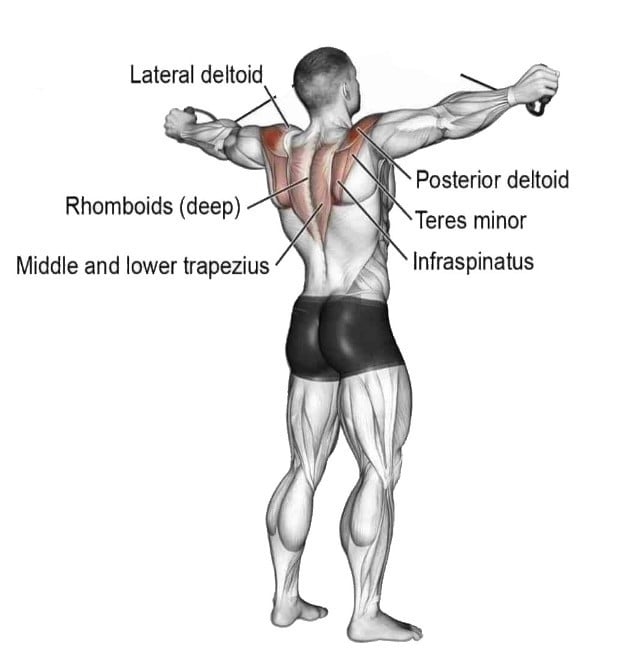
Want to take your gains to the next level? Discover your daily calorie needs with our free TDEE calculator
How To Do Standing Cable Reverse Fly
- Set the pulleys to the desired height, usually around chest level. Attach the D-handles to the cables. Check that both pulleys are the same height.
- Stand in the center of a cable apparatus. Position your feet shoulder-width apart for stability.
- Grab the left cable handle in your right hand and the right side handle in your left hand.
- Take a step back to create tension in the cable. Engage your core for stability.
- With your elbows slightly bent, pull your arms out to the sides in a controlled and deliberate manner. Squeeze your shoulder blades together as you do the move.
- Continue pulling your arms pull out and back as far as possible. Pause for a moment at the peak contraction, and feel the engagement in your rear deltoids.
- Slowly lower your arms back to the starting position.
- Aim for 10-15 repetitions per set.
Tips And Forms
- Set the cable pulley slightly above shoulder level. This setup aligns the resistance with the natural plane of your shoulder joint that effectively targets rear delt.
- The posterior deltoid is best targeted with your torso upright, not leaning too far forward or back.
- Keep your chest should be up, and your shoulders retracted. Engage your core muscles for stability and support.
- Maintain a controlled and slow pace during the exercise’s outward and inward phases.
- Keep your elbows slightly bent throughout the exercise. Avoid fully extending or locking out your elbows.
- Keep your elbows slightly higher than your wrists.
- Aim to bring your arms back until they’re in line with your torso. Going further can strain your shoulders.
- Squeeze your shoulder blades together at the top of the movement to activate your rear deltoid muscles.
- It is important to avoid excessive swinging or using too much weight, as this can compromise form and effectiveness.
- Exhale as you pull your arms back, and inhale as you come back. Keep your breathing steady.
- To maximize the benefits of the exercise, it’s important to establish a strong mind-muscle connection.
- As you become more comfortable with the form, feel free to change your set and rep ranges to challenge yourself.
- The number of reps you should do depends on your goals, whether to increase strength or build muscle mass and endurance. For muscle growth, it is best to do for around 6–12 reps per set. For muscle endurance: do 15-20+ reps per set.
| Level | Sets | Reps | Frequency |
|---|---|---|---|
| Beginner | 2-3 | 8-12 | 1-2 times per week |
| Intermediate | 3-4 | 8-12 | 2-3 times per week |
| Advanced | 4-5 | 8-15 | 2-3 times per week |
Reverse Cable Fly Variations
Above, we dissected the traditional variation of the cable rear delt fly. This fly version is what is usually seen and is an excellent back and shoulder exercise in its own right.
Furthermore, there are several variations that you can do to achieve different muscle activation. While the primary function of the exercise is there, these fly variations can really feel like a new movement.
1. Bent Over Reverse Cable Fly
Unlike dumbbell reverse fly, where the resistance varies during the lift, the cable pulley affords a uniform resistance throughout the motion.
When you bend over at the waist for this exercise, you hit your rear delts and upper back muscles from a different angle.
The bent-over position also enhances the engagement of the lower back, core, and glutes, which means it helps improve your stability and posture.
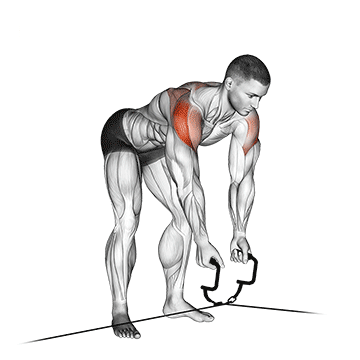
How To Do
- Adjust the cable machine to a low pulley and then attach D-handles to the cables.
- Maintain a neutral spine and keep your back flat as you bend forward at the waist. Hinge until your upper body is nearly parallel to the floor.
- Grab the handles attached to two low pulleys (left-side handle in right hand, right-side handle in left hand)
- Raise your hands outward and upward in an arc motion, similar to the regular reverse cable fly.
- Squeeze your shoulders together at the top of the movement.
- Then, slowly return to the starting position.
2. Seated Reverse Cable Fly
The seated position eliminates the possibility of utilizing momentum and makes the movement more challenging. The incline bench position also allows for greater isolation and activation of the rear deltoid muscles.
This exercise targets such small muscles, that’s why it is usually performed with lightweight for high reps, such as 10-15 reps per set or more.
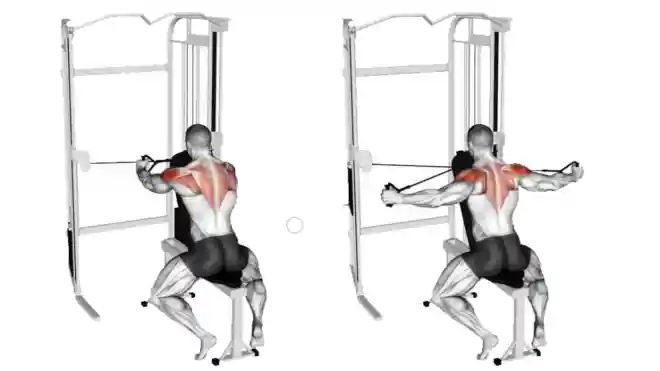
How To Do
- Place an incline bench sideways midway between two cable stations.
- Set an incline bench to a comfortable angle, typically between 60 to 80 degrees.
- Sit with your chest against the backrest and your feet planted firmly on the ground.
- Grasp the D-handles attached to the cables with the opposite hand.
- Keep your arms slightly bent, and pull the cables out to your sides.
- Slowly lower the cables back to the start, but don’t let the weight stack touch down at the bottom before beginning your next rep.
3. Single Arm Standing Reverse Cable Fly
The single-arm standing reverse cable fly is a unilateral variation of the reverse cable fly exercise, focusing on one arm at a time. Additionally, you should find that your mind-muscle connection is stronger during single arm exercise.
Doing the exercise with one arm at a time helps you find and fix any differences in strength or muscle size between your left and right sides. This helps your muscles to be more balanced and symmetrical.
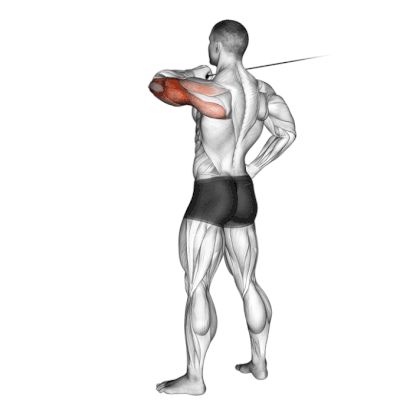
How To Do
- Adjust the cable machine to shoulder level and attach a single D-handle to the cable.
- Stand with your feet shoulder-width apart.
- Make sure that the left side of your body faces the cable pulley, and then grab the rope or D-handle with your right hand.
- Keep your core engaged, maintain a neutral spine, and avoid any twisting or compensatory movements.
- Exhale and extend your arm to the right, so your arm is straight.
- Inhale and slowly bring your arm back to the starting position.
- To ensure balance and symmetry, perform equal repetitions on each arm.
Benefits Of Reverse Cable Fly
Cable reverse fly exercises also help to:
- Targets and strengthens the rear deltoid muscles.
- Promotes balanced shoulder development.
- Improve posture by reducing the effects of rounded shoulders.
- It enhances shoulder stability and reduces the risk of injuries.
- Contributes to a more aesthetically pleasing upper body appearance.
- Benefits functional movements and athletic performance.
- Offers versatility for different fitness levels and goals.
- Build symmetry with the shoulder, preventing a “forward sloping” look
- Improve shoulder function, which is important because they help with movements like pulling, rowing, and throwing.
FAQ
Is The Cable Rear Delt Fly Good?
The cable rear delt fly is perhaps the best isolation exercise for your posterior deltoid and back. You need to be doing them.
What Muscle Does The Revers Fly Work?
The reverse fly works your upper back muscles and shoulder muscles, particularly the rear deltoids, on the backside of your shoulders.
Is it necessary to use heavy weights for the reverse cable fly?
It is not necessary to use heavy weights; focus on using a weight that allows you to perform the exercise with the correct technique and control.
The weight used for the reverse cable fly should be challenging enough to fatigue the muscles within the desired repetition range, while maintaining proper form.
Is reverse fly push or pull?
The reverse fly is a pulling exercise. In this exercise, you pull the weights or cables away from your body. Its pulling actions benefit the posterior shoulder and upper back.
Why is reverse fly so hard?
The reverse fly exercise can be challenging due to the weaker rear deltoid muscles, limited range of motion in the shoulders, lack of posterior chain strength, and the need for a strong mind-muscle connection. It also requires stability and balance.
Takeaways
Now that you know a few variations for your reverse cable fly, try each one out at the gym to get the full benefit. Don’t limit yourself to variations on this exercise, either.
The cable reverse fly is the perfect exercise, as it uses a light load and requires a tremendous mind-muscle connection.
Always look for new and interesting ways to perform all your staple movements so that you never get stuck waiting at the gym, never grow bored, and always keep growing.
Rear Delt Cable Exercises for Bigger and Stronger Shoulder

Manish is a NASM-certified fitness and nutrition coach with over 10 years of experience in weight lifting and fat loss fitness coaching. He specializes in gym-based training and has a lot of knowledge about exercise, lifting technique, biomechanics, and more.
Through “Fit Life Regime,” he generously shares the insights he’s gained over a decade in the field. His goal is to equip others with the knowledge to start their own fitness journey.

